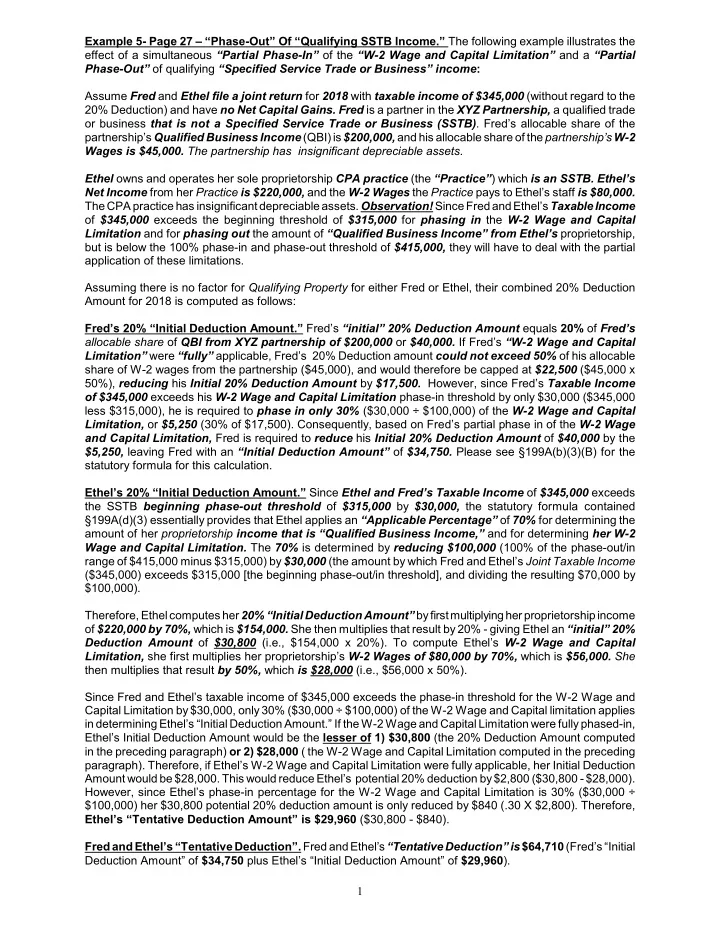

Example 5- Page 27 – “Phase-Out” Of “Qualifying SSTB Income.” The following example illustrates the effect of a simultaneous “Partial Phase-In” of the “W-2 Wage and Capital Limitation” and a “Partial Phase-Out” of qualifying “Specified Service Trade or Business” income : Assume Fred and Ethel file a joint return for 2018 with taxable income of $345,000 (without regard to the 20% Deduction) and have no Net Capital Gains. Fred is a partner in the XYZ Partnership, a qualified trade or business that is not a Specified Service Trade or Business (SSTB) . Fred’s allocable share of the partnership’s Qualified Business Income (QBI) is $200,000, and his allocable share of the partnership’s W-2 Wages is $45,000. The partnership has insignificant depreciable assets. Ethel owns and operates her sole proprietorship CPA practice (the “Practice” ) which is an SSTB. Ethel’s Net Income from her Practice is $220,000, and the W-2 Wages the Practice pays to Ethel’s staff is $80,000. The CPA practice has insignificant depreciable assets. Observation! Since Fred and Ethel’s TaxableIncome of $345,000 exceeds the beginning threshold of $315,000 for phasing in the W-2 Wage and Capital Limitation and for phasing out the amount of “Qualified Business Income” from Ethel’s proprietorship, but is below the 100% phase-in and phase-out threshold of $415,000, they will have to deal with the partial application of these limitations. Assuming there is no factor for Qualifying Property for either Fred or Ethel, their combined 20% Deduction Amount for 2018 is computed as follows: Fred’s 20% “Initial Deduction Amount.” Fred’s “initial” 20% Deduction Amount equals 20% of Fred’s allocable share of QBI from XYZ partnership of $200,000 or $40,000. If Fred’s “W-2 Wage and Capital Limitation” were “fully” applicable, Fred’s 20% Deduction amount could not exceed 50% of his allocable share of W-2 wages from the partnership ($45,000), and would therefore be capped at $22,500 ($45,000 x 50%), reducing his Initial 20% Deduction Amount by $17,500. However, since Fred’s Taxable Income of $345,000 exceeds his W-2 Wage and Capital Limitation phase-in threshold by only $30,000 ($345,000 less $315,000), he is required to phase in only 30% ($30,000 ÷ $100,000) of the W-2 Wage and Capital Limitation, or $5,250 (30% of $17,500). Consequently, based on Fred’s partial phase in of the W-2 Wage and Capital Limitation, Fred is required to reduce his Initial 20% Deduction Amount of $40,000 by the $5,250, leaving Fred with an “Initial Deduction Amount” of $34,750. Please see §199A(b)(3)(B) for the statutory formula for this calculation. Ethel’s 20% “Initial Deduction Amount.” Since Ethel and Fred’s Taxable Income of $345,000 exceeds the SSTB beginning phase-out threshold of $315,000 by $30,000, the statutory formula contained §199A(d)(3) essentially provides that Ethel applies an “Applicable Percentage” of 70% for determining the amount of her proprietorship income that is “Qualified Business Income,” and for determining her W-2 Wage and Capital Limitation. The 70% is determined by reducing $100,000 (100% of the phase-out/in range of $415,000 minus $315,000) by $30,000 (the amount by which Fred and Ethel’s Joint Taxable Income ($345,000) exceeds $315,000 [the beginning phase-out/in threshold], and dividing the resulting $70,000 by $100,000). Therefore, Ethel computes her 20% “Initial Deduction Amount” byfirstmultiplyingherproprietorship income of $220,000 by 70%, which is $154,000. She then multiplies that result by 20% - giving Ethel an “initial” 20% Deduction Amount of $30,800 (i.e., $154,000 x 20%). To compute Ethel’s W-2 Wage and Capital Limitation, she first multiplies her proprietorship’s W-2 Wages of $80,000 by 70%, which is $56,000. She then multiplies that result by 50%, which is $28,000 (i.e., $56,000 x 50%). Since Fred and Ethel’s taxable income of $345,000 exceeds the phase-in threshold for the W-2 Wage and Capital Limitation by $30,000, only 30% ($30,000 ÷ $100,000) of the W-2 Wage and Capital limitation applies in determining Ethel’s “Initial Deduction Amount.” If the W-2 Wage and Capital Limitation were fully phased-in, Ethel’s Initial Deduction Amount would be the lesser of 1) $30,800 (the 20% Deduction Amount computed in the preceding paragraph) or 2) $28,000 ( the W-2 Wage and Capital Limitation computed in the preceding paragraph). Therefore, if Ethel’s W-2 Wage and Capital Limitation were fully applicable, her Initial Deduction Amount would be $28,000. This would reduce Ethel’s potential 20% deduction by $2,800 ($30,800 - $28,000). However, since Ethel’s phase-in percentage for the W-2 Wage and Capital Limitation is 30% ($30,000 ÷ $100,000) her $30,800 potential 20% deduction amount is only reduced by $840 (.30 X $2,800). Therefore, Ethel’s “Tentative Deduction Amount” is $29,960 ($30,800 - $840). Fred and Ethel’s “Tentative Deduction”. Fred and Ethel’s “Tentative Deduction” is $64,710 (Fred’s “Initial Deduction Amount” of $34,750 plus Ethel’s “Initial Deduction Amount” of $29,960 ). 1
Fred and Ethel’s Total 20% Deduction Amount For 2018. Fred and Ethel’s aggregate 20% Deduction amount may not exceed the lesser of 1) their “Tentative Deduction” of $64,710 or 2) 20% of their Taxable Income ($345,000), less net capital gains (zero) which is $69,000. Therefore, Fred and Ethel’s aggregate “allowable” 20% Deduction amount for 2018 is $64,710. 2
C CORP. - MAXIMUM BRACKETS 2017 2018 C Corporation - Corp Rate 35.00 21.00 Dividend Rate 23.80 23.80 X .65 X .79 Eff. Div. Rate 15.47 18.80 Total 50.47 39.80
S Corporation - Not Specified Service Trade Or Business 2017 2018 Max. Ind. Rate 39.60 29.60 (80% X 37%) Phase-out Itemized 1.19 Total 40.79 C Corp. Rate 50.47 39.80 Difference 9.68 10.20 S Corporation - Specified Service Trade Or Business Ind. Rate-Above 40.79 37.00 C Corp. Rate 50.47 39.80 Difference 9.68 2.80
Recommend
More recommend